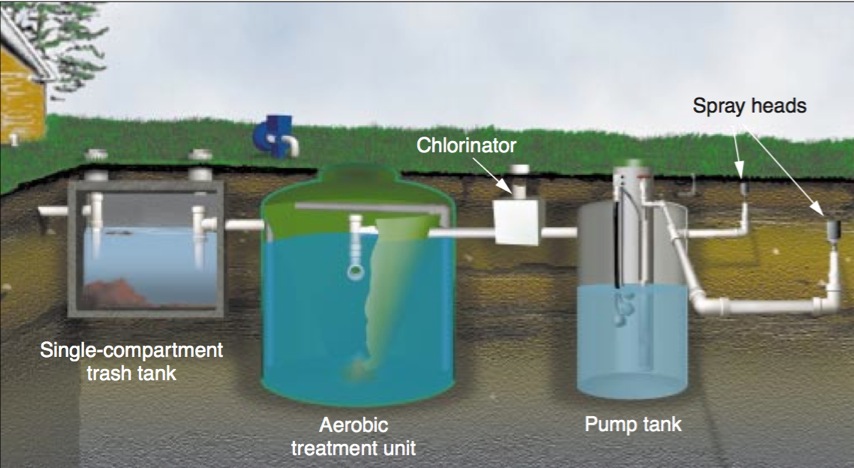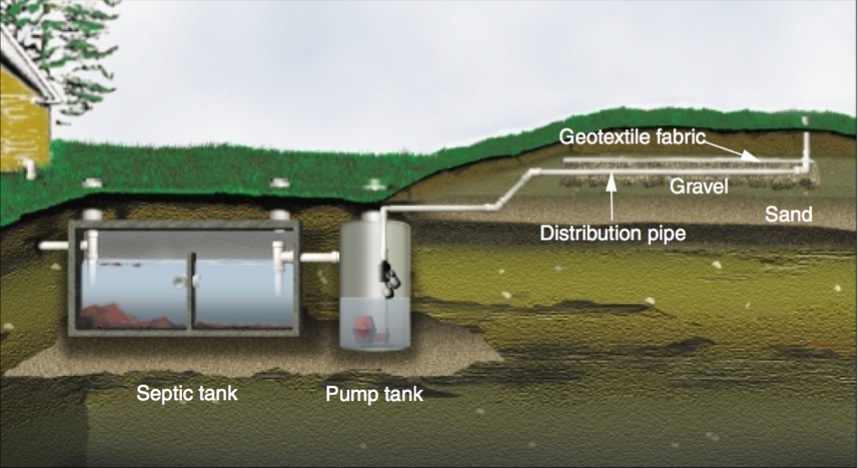Neptune Harbor Subdivision
On-Site Sewage Facilities Requirements
Neptune Harbor subdivison has both conventional with lateral lines and aerobic septic systems in place. I am unsure if any mound systems exist in our area. At some point, we will all experience a septic issue and we need to know what must be done prior to doing anything with our systems. Contact Aransas County Environmental Health Department, (361) 790-0121 for more information or simply click here to visit their site for more detailed information. Photo of aerobic and mound system at bottom of page.
After speaking with Erick DeFosset of the Aransas County Environmental Health Department, he was kind enough to supply us with the following information:
Is It Time For A New Septic System?
The majority of the septic systems put in back in the early 80’s and before were called conventional systems. These systems usually consisted of a tank or two and then a pipe or series of pipes that are perforated so that the liquids could leach into the soil. Many of these systems were put in when permits were not required, on the same note some did receive permits. When many of these systems were put in, groundwater was not an issue at the time, since then it has been found that if the effluent coming from the leach field does not have a minimum of 24 inches below the bottom of the drain field, groundwater can become contaminated. With this being said, the majority of conventional systems in Aransas County must be changed out to a newer type of system once there is a failure with either the tanks or the drain field.
According to the Aransas County Environmental Health and TCEQ (Texas Commission for Environmental Quality), a septic system must be updated to the current standards whenever the sewage starts backing up into the house, due to overfilled septic system, or when fluids start surfacing around the drain field area, or around the septic tanks. A malfunctioning septic system is not only a violation of the Texas Health and Safety Code and can carry severe penalties, but also a public health risk. Raw sewage can cause numerous diseases including but not limited to e-coli, hepatitis, meningitis, and typhoid. It is important to remember that under no circumstances can a drain field be repaired, altered, or extended in any way. Some systems however that need minor repairs may be done only by licensed installers.
What Steps and Options Do I Have?
The first step to replacing your septic system is to contact a Professional Engineer or Registered Sanitarian to get a proper site evaluation. Many factors go into what type of septic system you can place on a property other than soil type; some of those include size of lot, distance from public waterways, water wells, and size of house. Once the site evaluation is done, the R.S. or the P.E. can recommend what type of system will fit on your property in accordance with TCEQ and Aransas County standards. Once the design is completed then a licensed installer can be notified for price quote for the system needed.
There are three different types of systems that can usually be placed on a property that are approved. One type of system is the mound system. This system is usually the most simplistic of the systems. It consists of a series of septic tanks, pump tank, and the disposal area. The disposal area is a raised area about 2 feet high that the lateral lines are placed into. This type of system only has one pump that pumps the effluent into the mound and no maintenance contract is required.
The second type of system that may be used is the aerobic treatment unit with surface spray application. This system usually requires more square footage as far as disposal area. The tanks that are used are also in a series with one of the chambers being an aeration chamber and another one used as the pump chamber with a type of disinfection. The disposal of the effluent passes through the disinfection device and then pumped out through a sprinkler system onto the yard. This system has an aeration pump and a pump for the sprinkler system and requires a yearly maintenance contract.
The last type of system is the aerobic treatment system with drip emitters. The two main differences with the drip system and the spray are based on the type of disposal and the size of area needed. It can be placed in almost all types of soils and it is placed about 6 inches below the surface. Depending on the distance from public waterways, disinfection may not be necessary for this system. This system also uses less square footage than a spray system but still has two pumps and requires a yearly maintenance contract.
All of these systems described above are approved through the TCEQ and Aransas County for use and must be designed by an R.S. or a P.E. Installation and repairs to any type of systems must be done by TCEQ licensed installers. If something does not look right, such as a backyard being torn up or 3-4 inch diameter lines being placed in the ground or if you have any questions in regards to your own septic system, call the Aransas County Environmental Health Department.
Who Do I Call For Questions?
For any septic complaints or questions including lists of Registered Sanitarian and Installers, contact Erick DeFosset at Aransas County Environmental Health. All calls will be kept anonymous unless told otherwise. The phone number for ACEH is 361-790-0121.
Thank You For Your Time
Erick DeFosset
DR, CFM
361-790-0121
After speaking with Erick DeFosset of the Aransas County Environmental Health Department, he was kind enough to supply us with the following information:
Is It Time For A New Septic System?
The majority of the septic systems put in back in the early 80’s and before were called conventional systems. These systems usually consisted of a tank or two and then a pipe or series of pipes that are perforated so that the liquids could leach into the soil. Many of these systems were put in when permits were not required, on the same note some did receive permits. When many of these systems were put in, groundwater was not an issue at the time, since then it has been found that if the effluent coming from the leach field does not have a minimum of 24 inches below the bottom of the drain field, groundwater can become contaminated. With this being said, the majority of conventional systems in Aransas County must be changed out to a newer type of system once there is a failure with either the tanks or the drain field.
According to the Aransas County Environmental Health and TCEQ (Texas Commission for Environmental Quality), a septic system must be updated to the current standards whenever the sewage starts backing up into the house, due to overfilled septic system, or when fluids start surfacing around the drain field area, or around the septic tanks. A malfunctioning septic system is not only a violation of the Texas Health and Safety Code and can carry severe penalties, but also a public health risk. Raw sewage can cause numerous diseases including but not limited to e-coli, hepatitis, meningitis, and typhoid. It is important to remember that under no circumstances can a drain field be repaired, altered, or extended in any way. Some systems however that need minor repairs may be done only by licensed installers.
What Steps and Options Do I Have?
The first step to replacing your septic system is to contact a Professional Engineer or Registered Sanitarian to get a proper site evaluation. Many factors go into what type of septic system you can place on a property other than soil type; some of those include size of lot, distance from public waterways, water wells, and size of house. Once the site evaluation is done, the R.S. or the P.E. can recommend what type of system will fit on your property in accordance with TCEQ and Aransas County standards. Once the design is completed then a licensed installer can be notified for price quote for the system needed.
There are three different types of systems that can usually be placed on a property that are approved. One type of system is the mound system. This system is usually the most simplistic of the systems. It consists of a series of septic tanks, pump tank, and the disposal area. The disposal area is a raised area about 2 feet high that the lateral lines are placed into. This type of system only has one pump that pumps the effluent into the mound and no maintenance contract is required.
The second type of system that may be used is the aerobic treatment unit with surface spray application. This system usually requires more square footage as far as disposal area. The tanks that are used are also in a series with one of the chambers being an aeration chamber and another one used as the pump chamber with a type of disinfection. The disposal of the effluent passes through the disinfection device and then pumped out through a sprinkler system onto the yard. This system has an aeration pump and a pump for the sprinkler system and requires a yearly maintenance contract.
The last type of system is the aerobic treatment system with drip emitters. The two main differences with the drip system and the spray are based on the type of disposal and the size of area needed. It can be placed in almost all types of soils and it is placed about 6 inches below the surface. Depending on the distance from public waterways, disinfection may not be necessary for this system. This system also uses less square footage than a spray system but still has two pumps and requires a yearly maintenance contract.
All of these systems described above are approved through the TCEQ and Aransas County for use and must be designed by an R.S. or a P.E. Installation and repairs to any type of systems must be done by TCEQ licensed installers. If something does not look right, such as a backyard being torn up or 3-4 inch diameter lines being placed in the ground or if you have any questions in regards to your own septic system, call the Aransas County Environmental Health Department.
Who Do I Call For Questions?
For any septic complaints or questions including lists of Registered Sanitarian and Installers, contact Erick DeFosset at Aransas County Environmental Health. All calls will be kept anonymous unless told otherwise. The phone number for ACEH is 361-790-0121.
Thank You For Your Time
Erick DeFosset
DR, CFM
361-790-0121
An on-site wastewater treatment system using an aerobic treatment unit.

A mound system for distributing treated wastewater to the soil.